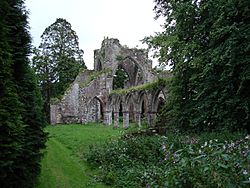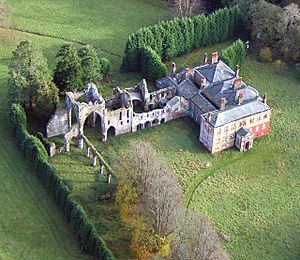Calder Abbey facts for kids

Calder Abbey today
|
|
| Monastery information | |
|---|---|
| Full name | Calder Abbey |
| Order | Savigniac, then Cistercian |
| Established | 1135 |
| Disestablished | 1536 |
| Mother house | Furness Abbey |
| Diocese | York |
| People | |
| Founder(s) | Ranulf de Gernon |
| Site | |
| Location | Calderbridge, Cumbria, England |
| Visible remains | One nave arcade , base of tower, east cloister range, monk's bridge. |
| Public access | No |
Calder Abbey is an old monastery in Cumbria, England. It was first started in 1134 by a group of monks called the Savigniacs. They came from Furness Abbey. Later, in 1148, the abbey became part of the Cistercian order. It is located near the village of Calderbridge.
Contents
History of Calder Abbey
How Calder Abbey Started
Ranulf de Gernon founded Calder Abbey on January 10, 1134. He gave the monks land and a mill. The first buildings were made of wood. Twelve Savigniac monks from Furness Abbey lived there. Their leader was Abbot Gerold.
Troubles and a New Home
Only four years later, in 1138, Scottish raiders attacked the area. They were led by William Fitz Duncan. Calder Abbey was damaged, and the monks were forced to leave. They went back to Furness Abbey for safety.
However, a disagreement happened there. The monks from Calder had to leave Furness Abbey. They began to travel around, looking for a new home. They finally settled in a place called Stocking. There, they built a very large abbey known as Byland Abbey.
In 1142, the monks of Calder were officially freed from Furness Abbey's control. This meant they could make their own decisions.
Rebuilding and New Order
Around 1142, a second group of monks from Furness Abbey came to Calder. They tried to start the abbey again. This time, they had protection from Fitz Duncan.
In 1148, the Savigniac order joined with the Cistercian order. Because of this, Calder Abbey also became a Cistercian monastery.
By 1180, a stone church was built at the abbey. The main part that remains today is the west door. Most of the other buildings were rebuilt around 1220. This was done in a style called Early English.
The Abbey's End
Calder Abbey was not a very rich monastery. In 1535, its yearly income was only about £50. When King Henry VIII decided to close all the monasteries in England, Calder Abbey was one of them. This event is called the Dissolution.
In 1535, some people sent by the King made a report about the abbey. Their report was not very positive about the monks living there. However, these reports were often unfair.
The last abbot, Richard Ponsonby, gave up the abbey in 1536.
After the Abbey Closed
What Happened to the Buildings
After the Dissolution, King Henry VIII gave Calder Abbey to Sir Thomas Leigh. Sir Thomas removed the roof and sold it. He also sold anything else he could from the church. This turned the church into a ruin.
Over the years, many different private owners have had the abbey. It is still privately owned today.
Some parts of the old monastery buildings are still standing. They are now part of a house called Calder Abbey House. This house was mostly built in the early 1800s. Other parts, like the chapter house, are still ruins nearby. The ruins are very beautiful and are kept as a scenic feature. The abbey and its grounds are private. This means they are not open to the public. New trees also block much of the view from nearby land.
Modern Celebration of the Abbey
In 1934, people celebrated the 800th anniversary of the abbey's founding. A special church service was held in the ruined abbey. Over 2,000 people attended this celebration. It was led by Dr. Thomas Wulstan Pearson, who was a Roman Catholic Bishop.
The Monk's Bridge
There is a very old bridge near the abbey called the Monk's Bridge. The monks of Calder built it on Cold Fell. It is the oldest packhorse bridge in Cumbria. It crosses the River Calder. This bridge is still used today and is open to the public.
Images for kids



